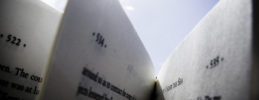
('Painter's Palette at the Ready' © Cobalt123, 2008)
FIFTY POUNDS BY WEIGHT IN ASHES
by MIKE SMITH
As a child I read and enjoyed the stories and poems of Rudyard Kipling’s The Jungle Book, but as an adult I fell prey to the idea that he was too much an imperialist for decent people to read. Then, quite recently, I discovered the five-volume Folio Society edition of his short stories. From his 1926 collection, Debits and Credits, comes ‘The Eye of Allah’. Set in the monastery of St Illod it tells of the artist John of Burgos, who early on in the story, travels abroad to find ‘new devils’ to draw, to buy pigment, and to visit his ‘Infidel’ and pregnant unofficial wife. He returns with his drawings of devils, and his paints, but the wife has died in childbirth. Kipling gives us this information through dialogue, in his typically economical way:
“You left all well there?” Anne asked. (Maybe the Abbot had told her something of John’s confession.)
“I left all in the hands of God”
“Ah me! How long since?”
“Four months less eleven days.”
“Were you – with her?”
“In my arms. Child-bed.”
“And?”
“The boy too. There is nothing now.”
I doubt you’ll find a bleaker, nor terser conversation in any modern novel or short story, Cormac McCarthy included! There is no authorial commentary or explanation of the meaning of this conversation whatsoever: ‘show don’t tell’, as some would have it; ‘tell don’t explain’ as I prefer.
Much of the early part of the story focuses on John. His character, outlooks and understanding align the reader with him. He is forward looking, not bound by the conventions of his time, but not gratuitously rebellious either, and he is respected by the other characters. It is clear from early on that it is his shoulder we perch on as the story unfolds. His views on race, though, more than half a millennium after the period in which the story is set, and nearly a century after it was published, would still be considered avant-garde by some; Kipling remains a modern, and contentious writer.
“Is she Moorish or – or Hebrew?”
“She’s mine,” John returned.
“Is that enough?”
“I have found it so.”
 The story moves towards a conversation between the Abbott – his seigniorial ring removed and dropped into a wine cup to signal that what is said will be considered ‘off the record’ – a Friar, Thomas the Infirmarian, a Sub-Cantor of the Monastery, John himself, and a visiting Doctor, Roger of Salerno. Their conversation settles on the devils that John has drawn, and on the microscopic organisms that have inspired them, for John has ‘the eye of Allah’ – an early, but effective contraption of wood, metal and glass, or crystal, that reveals what the Church thinks of as the ‘devils’ in a droplet of water. The Abbot, who has been a prisoner of the Saracens, has seen such a device before, and has seen with it, but as the conversation develops he argues that to know of and to see such things is to transgress the Church’s rules, and risk the stake: “…where do we stand?” asks Roger of Salerno. “At the stake,” replies the Abbott of St Illod.
The story moves towards a conversation between the Abbott – his seigniorial ring removed and dropped into a wine cup to signal that what is said will be considered ‘off the record’ – a Friar, Thomas the Infirmarian, a Sub-Cantor of the Monastery, John himself, and a visiting Doctor, Roger of Salerno. Their conversation settles on the devils that John has drawn, and on the microscopic organisms that have inspired them, for John has ‘the eye of Allah’ – an early, but effective contraption of wood, metal and glass, or crystal, that reveals what the Church thinks of as the ‘devils’ in a droplet of water. The Abbot, who has been a prisoner of the Saracens, has seen such a device before, and has seen with it, but as the conversation develops he argues that to know of and to see such things is to transgress the Church’s rules, and risk the stake: “…where do we stand?” asks Roger of Salerno. “At the stake,” replies the Abbott of St Illod.
On the other side of the argument, the Friar and Roger of Salerno put forward the side of science, by close observation and analysis. Yet Roger too is aware of the danger they are in for even having such thoughts, let alone expressing them. The Friar claims to know ‘men who dare think’, to which Roger’s response is: ‘“Find them! … Five or six in all the world. That makes less than fifty pounds by weight in ashes…”’
These are matters of life and death, and not only through the possibility of curing disease. John of Burgos has served most of his purpose as a character in the story, by the provision of ideas that we can accept as humane and reasonable, and also by the possession of the microscope. The issue has come down to whether what has been seen through ‘the eye of Allah’ is ‘Art Magic’, or ‘Art optical’. The argument is between knowledge and faith and is conducted by the ‘heavyweights’, Roger of Salerno and the Abbott. Between them is the Friar, who is won over. John and Thomas have become witnesses to be called at the trial of the idea. At its conclusion the Abbott retrieves his ring and destroys the microscope. It is for Kipling’s narrator to report this destruction, but the justification for it is given by the Abbott in the penultimate paragraph: “We have seen what we have seen.”
This is a tragic story. All these men ‘have seen what they have seen’, and they have agreed upon it. What the Abbott must assert is that the evidence of their eyes is to be suppressed, despite not having been refuted. ‘The choice lies between two sins. To deny the world a Light which is under our hand, or to enlighten the world before her time.’
Kipling’s conundrum, from nearly a century ago, and written, presumably, in the shadow of the First World War, is as potent today as it was then, maybe more so. In our time, as in his, it raises the question of not only the nature of ‘enlightenment’, but also the timing of it. Kipling’s Abbott fears that ‘it will be the mother of more death, more torture, more division, and greater darkness’. For the Abbott, the ‘Light’ of religion must extinguish the ‘Light’ of a knowledge that has been acquired too soon. His experience with the Saracens leads him to the warning: ‘I know what doctrine they drew from it.’ Did Kipling, I wonder, still have that fear – having seen the carnage, in a very personal way, of the recent war – that knowledge is ‘untimely’? In the next generation, Hitler spoke of the ‘big lie’, and Churchill warned that the truth needed a ‘bodyguard of lies’. Do we still fear the threats that new knowledge brings? The division is still with us, and still potent. Scripture trumps experience.
The meek Thomas the Infirmarian has a theory of disease, and one that ‘the eye of Allah’ would, and in this story does, prove: ‘I confess myself at a loss for the cause of the fever unless … certain small animals which the eye cannot follow enter the body.’ But having been prompted to reveal it, he ends with: ‘On the other hand, this is not in Scripture.’ The Italian Doctor vents the frustration of the scientist: “Always that!” The artist John has already, when he is being told about the ‘wisdom dinner’, given us an opinion that will underlie the later scene: ‘Three Doctors … I’ve always found that means two atheists.’
 The argument between these medieval characters has a wider relevance too, I believe, for it touches on that difficulty we all have with being bound by decisions that others have imposed on us when their arguments, rightly or wrongly, have failed to convince us.
The argument between these medieval characters has a wider relevance too, I believe, for it touches on that difficulty we all have with being bound by decisions that others have imposed on us when their arguments, rightly or wrongly, have failed to convince us.
The collection in which this story appeared contained other stories of significance. One, ‘The Gardener’, has been seen as one of Kipling’s greatest stories, and like this one, it is a story rooted in a religious apprehension of life. The high themes of such stories are sometimes approached obliquely, through the presentation of physical events. An example of such might be Ambrose Bierce’s questionings of whether or not life is an illusion of the dying and the already dead, as in ‘An Occurrence at Owl Creek Bridge’. It might be by authorial commentary, as in James Joyce’s ‘The Dead’. But there is also what might be considered almost a genre, certainly a sub-genre, of its own, in which a writer sets up a group of people who will debate before us the issue to which he or she wishes our attention to be drawn.
It’s a high-risk strategy, for debate is not action, and it calls for an author who can marshal opinions that are convincing on both sides, and put them into words that compel us to read on. Having a reader want to know what will be said next, as opposed to what will happen next, is a high bar to set. That Kipling clears it, and I believe he does, might be, at least to some extent, because he has set his story so far into his past that it seems not much further away from ours a hundred years later. Perhaps it is also because his writing has a clarity of style that eclipses that last hundred years, and because the debate he initiates and follows through is as important and as unresolved today as it was in his own time.
~



One thought on “Fifty Pounds by Weight in Ashes”
Comments are closed.